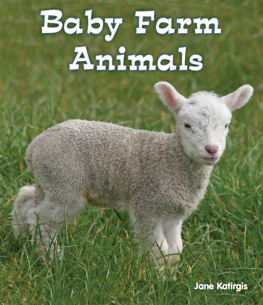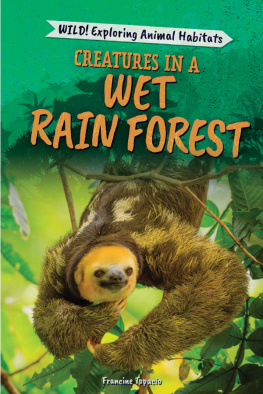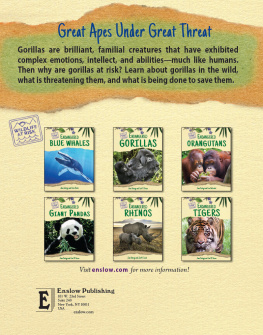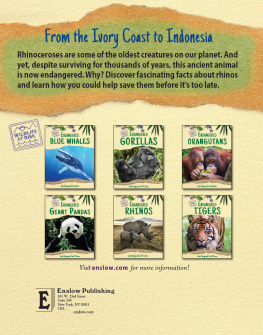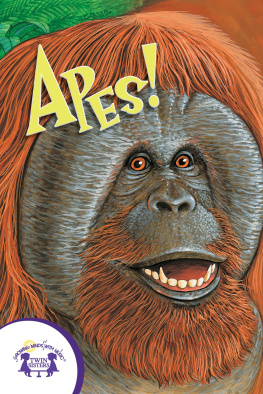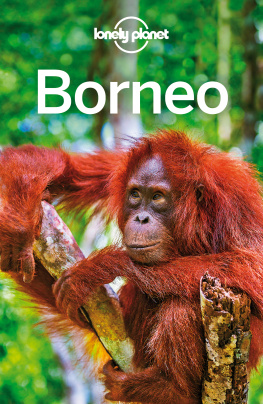Published in 2016 by Enslow Publishing, LLC.
101 W. 23rd Street, Suite 240, New York, NY 10011
Copyright 2016 by Enslow Publishing, LLC.
All rights reserved.
No part of this book may be reproduced by any means without the written permission of the publisher.
Library of Congress Cataloging-in-Publication Data
Katirgis, Jane, author.
Endangered orangutans / Jane Katirgis and Lisa Harkrader.
pages cm. (Wildlife at risk)
Summary: Discusses orangutans, why they are endangered and how they are being helpedProvided by publisher.
Audience: Ages 11+.
Audience: Grades 7 to 8.
Includes bibliographical references and index.
ISBN 978-0-7660-6886-5 (library binding)
ISBN 978-0-7660-6884-1 (pbk.)
ISBN 978-0-7660-6885-8 (6-pack)
1. OrangutansJuvenile literature. 2. Endangered speciesJuvenile literature. 3. Orangutans ConservationJuvenile literature. I. Harkrader, Lisa, author. II. Title.
QL737.P94K38 2016
599.883dc23
2015009974
Printed in the United States of America
To Our Readers: We have done our best to make sure all Web site addresses in this book were active and appropriate when we went to press. However, the author and the publisher have no control over and assume no liability for the material available on those Web sites or on any Web sites they may link to. Any comments or suggestions can be sent by e-mail to .
Portions of this book originally appeared in the book The Orangutan.
Photos Credits: Anup Shah/Stone/Getty Images, p..
Cover Credits: Christopher Chan/Moment/Getty Images (orangutans); Creativ Studio Heinemann/ Creative (RF)/Getty Images (borage flowers); Joakim Leroy/E+/Getty Images (palm leaf); Maria Toutoudaki/Photodisk/Getty Images (background paper texture).
ORANGUTANS AT A GLANCE
Scientific Name
Sumatran orangutans are Pongo abelii.
Bornean orangutans are Pongo pygmaeus.
Height
Males average 4.5 feet (1.35 meters).
Females average 3.5 feet (1.05 meters).
Weight
Males weigh from 165 to 300 pounds (75 to 136 kilograms) in the wild and up to 400 pounds (180 kilograms) or more in captivity. Females weigh from 80 to 120 pounds (36 to 54 kilograms).
Hair
Shaggy reddish brown to light orange.
The hair of Bornean orangutans is smoother and browner.
The hair of Sumatran orangutans is fluffier and redder.
Range
The rain forests of Borneo and Sumatra, two islands located in Southeast Asia.
Breeding Season
None. Orangutans, like humans, can breed at any time throughout the year, but females only mate and give birth every 3 to 5 years.
Gestation
8.5 months
Number of Young in One Birth
Usually only one
Life Span
Up to 60 years in captivity
Status
Bornean orangutans are endangered. Sumatran orangutans are critically endangered.
Number of Individuals Remaining
Approximately 45,00069,000 in Borneo and 7,300 in Sumatra
Main Threat to Survival
Humans, who clear thousands of acres of rain forest each year for agriculture, logging, and mining.
chapter one
GREAT APES OF ASIA
They are the largest tree-dwelling animals in the world. They are red apes that have long fascinated explorers. They are two distinct speciesSumatran and Borneanand they are both endangered. They are orangutans, the only great apes of Asia.
Some native people of Borneo and Sumatra believed these apes were Gods first try at making humans. Others thought they were humans who had fled to the forest. Many native people believed these creatures knew how to talk but refused to speak in front of humans because they were afraid humans would put them to work.
Numbers Are Dropping
In ancient times, orangutans ranged through Southeast Asia into Southern China and as far west as India. But at the end of the last ice age, ten thousand to twenty thousand years ago, orangutans disappeared on the mainland of Asia. Today they survive only in small pockets of rain forest on the islands of Sumatra and Borneo. Sumatra is part of the country of Indonesia. Borneo, the third largest island in the world after Greenland and Papua New Guinea, is divided into three countries. The Southeastern two thirds of the island is part of Indonesia. The northern third is part of Malaysia. The tiny independent country of Brunei is notched out of the Northwestern coast. Orangutans live in the Indonesian and Malaysian parts of Borneo.
A mother and baby orangutan, two examples of the endangered red apes, live in a reserve in Borneo, Indonesia.
Scientists estimate that in 1900, there were more than three hundred thousand orangutans living in the wild. Today, between 45,000 and 59,000 live in Borneo, while about 7,300 live in Sumatra.
Bornean orangutans are listed as endangered, and Sumatran orangutans are critically endangered. Many countries give orangutans legal protection as endangered species. But their population has shrunk by half since the 1950s. The biggest threat to orangutans is the loss of their habitat. Eighty percent of Indonesias original rain forests have been cleared for logging, farming, and mining. The habitat loss continues; each year, more than 6 million acres (2.4 million hectares) are destroyed. Many scientists predict that without major conservation efforts, orangutans could become extinct by 2035.
No Pets Allowed
In the 1980s, a popular television program called The Naughty Family aired in Taiwan. The show starred a family that owned a pet orangutan. Since then, many people in Asia have clamored to own pet orangutans, and although it is against the law to sell orangutans because they are endangered, an illegal orangutan trade has sprung up. Poachers kill mother orangutans and take their babies to sell as pets on the black market. About two thirds of the captured babies die.
Fast Fact!
In 2008 and 2009, Indonesia entered the Guinness Book of World Records for having the highest rate of deforestation of any country on our planet.
Researchers estimate that two hundred to five hundred baby orangutans are traded each year as pets. About twice that many die on their way to be sold, and poachers also kill the mother orangutans to capture their babies.
Those surviving babies do not fare well. Baby orangutans are cute and cuddly, but those babies grow up. Adult orangutans weigh as much as or more than adult humans and are much stronger. They are hard to manage, which leads some owners to abandon them. Others take them to rehabilitation centers, where experts work toward one day releasing them into the wild.
Conservation Challenges
Wild orangutans do not live in one country. Part of their habitat is in Indonesia, and part is in Malaysia. The borders between the countries make it hard to coordinate conservation efforts. The rain forest habitat is dense and remote, which makes it difficult for governments to enforce conservation laws and keep orangutans and their habitat safe.
Fast Fact!
When it rains, orangutans make umbrellas out of large leaves.
In recent years, the Indonesian government went through a state of upheaval. The political unrest made orangutan protection even more difficult. And the horrible destruction and loss of life in coastal Sumatra caused by the earthquake and tsunami of December 2004 made it more difficult to save orangutans in a place where many people had little to begin with.



